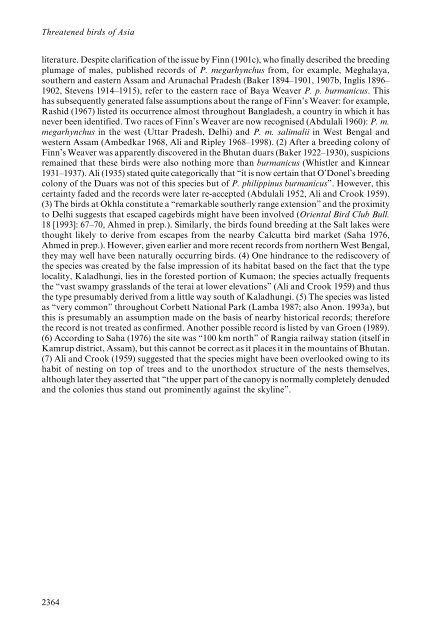Threatened Birds of Asia: - BirdLife International
Threatened Birds of Asia: - BirdLife International
Threatened Birds of Asia: - BirdLife International
Create successful ePaper yourself
Turn your PDF publications into a flip-book with our unique Google optimized e-Paper software.
<strong>Threatened</strong> birds <strong>of</strong> <strong>Asia</strong><br />
literature. Despite clarification <strong>of</strong> the issue by Finn (1901c), who finally described the breeding<br />
plumage <strong>of</strong> males, published records <strong>of</strong> P. megarhynchus from, for example, Meghalaya,<br />
southern and eastern Assam and Arunachal Pradesh (Baker 1894–1901, 1907b, Inglis 1896–<br />
1902, Stevens 1914–1915), refer to the eastern race <strong>of</strong> Baya Weaver P. p. burmanicus. This<br />
has subsequently generated false assumptions about the range <strong>of</strong> Finn’s Weaver: for example,<br />
Rashid (1967) listed its occurrence almost throughout Bangladesh, a country in which it has<br />
never been identified. Two races <strong>of</strong> Finn’s Weaver are now recognised (Abdulali 1960): P. m.<br />
megarhynchus in the west (Uttar Pradesh, Delhi) and P. m. salimalii in West Bengal and<br />
western Assam (Ambedkar 1968, Ali and Ripley 1968–1998). (2) After a breeding colony <strong>of</strong><br />
Finn’s Weaver was apparently discovered in the Bhutan duars (Baker 1922–1930), suspicions<br />
remained that these birds were also nothing more than burmanicus (Whistler and Kinnear<br />
1931–1937). Ali (1935) stated quite categorically that “it is now certain that O’Donel’s breeding<br />
colony <strong>of</strong> the Duars was not <strong>of</strong> this species but <strong>of</strong> P. philippinus burmanicus”. However, this<br />
certainty faded and the records were later re-accepted (Abdulali 1952, Ali and Crook 1959).<br />
(3) The birds at Okhla constitute a “remarkable southerly range extension” and the proximity<br />
to Delhi suggests that escaped cagebirds might have been involved (Oriental Bird Club Bull.<br />
18 [1993]: 67–70, Ahmed in prep.). Similarly, the birds found breeding at the Salt lakes were<br />
thought likely to derive from escapes from the nearby Calcutta bird market (Saha 1976,<br />
Ahmed in prep.). However, given earlier and more recent records from northern West Bengal,<br />
they may well have been naturally occurring birds. (4) One hindrance to the rediscovery <strong>of</strong><br />
the species was created by the false impression <strong>of</strong> its habitat based on the fact that the type<br />
locality, Kaladhungi, lies in the forested portion <strong>of</strong> Kumaon; the species actually frequents<br />
the “vast swampy grasslands <strong>of</strong> the terai at lower elevations” (Ali and Crook 1959) and thus<br />
the type presumably derived from a little way south <strong>of</strong> Kaladhungi. (5) The species was listed<br />
as “very common” throughout Corbett National Park (Lamba 1987; also Anon. 1993a), but<br />
this is presumably an assumption made on the basis <strong>of</strong> nearby historical records; therefore<br />
the record is not treated as confirmed. Another possible record is listed by van Groen (1989).<br />
(6) According to Saha (1976) the site was “100 km north” <strong>of</strong> Rangia railway station (itself in<br />
Kamrup district, Assam), but this cannot be correct as it places it in the mountains <strong>of</strong> Bhutan.<br />
(7) Ali and Crook (1959) suggested that the species might have been overlooked owing to its<br />
habit <strong>of</strong> nesting on top <strong>of</strong> trees and to the unorthodox structure <strong>of</strong> the nests themselves,<br />
although later they asserted that “the upper part <strong>of</strong> the canopy is normally completely denuded<br />
and the colonies thus stand out prominently against the skyline”.<br />
2364
















